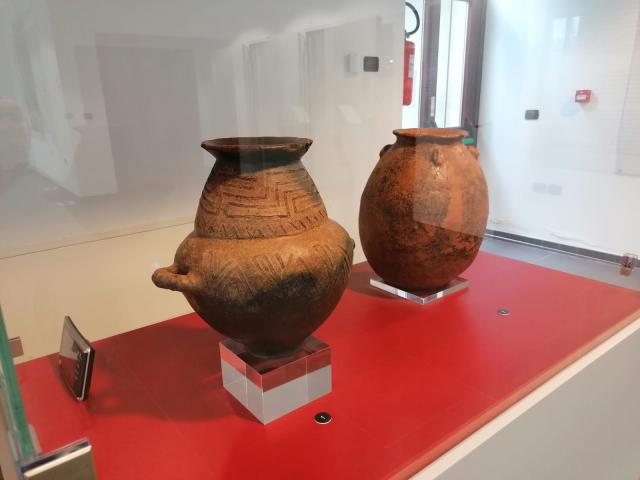Cinerary vessels of Villanovan culture
Antiquarium

Two cinerary vessels dating back to the Iron Age testify the spread of the Villanovan culture in the area between Perugia and Lake Trasimeno. The term “Villanovan” conventionally defines a cultural aspect of protohistoric Italy (9th-13th century B.C.), recognised essentially from archaeological sources, or from the characteristics of material remains. The interested area of the Villanovan culture extended far beyond the Emilia-Romagna region among the Apennines, the Adriatic and the Po, including quite a large area bordered by the River Arno, the Tiber and Tyrrhenian coast, corresponding to current Tuscany and northern Lazio and also affects Chiugi and the Trasimeno area. One of the main characteristics of the Villanovan civilization is the almost exclusive use of cremation as a funeral rite, to which is added the use of a biconical vase as a container for ashes. These ashes were closed by overturned bowls or, at times, by helmets for some burials of eminent males. Next to the vessel containing the ashes grave goods were placed, a selection of everyday objects, tools and utensils, personal ornaments, horse harnesses, weapons, but also bronze pottery containers.
The quantity and quality of grave goods have always been important chronological as well as social indicators for scholars, because these parameters at first only distinguished the gender of the deceased, but starting from the 8th century B.C., also the rank and role that the individual had held in life. Villanovan society initially did not differentiate very much from a social point of view, it was dedicated to intensive farming and livestock. Gradually specialized craft activities – metallurgic and ceramic production – generated accumulations of wealth and favoured social stratification, leading to the emergence of an aristocratic class that also promoted and controlled commercial trading relations with the other protohistoric realities. The Villanovan communities lived in villages of huts grouped in small nuclei with areas of common use, made with a load-bearing structure of wooden poles, cane walls, plastered and finished in clay, and the roof always in woven reeds on inclined beams.
Inside the huts the hearth dominated and the floor of beaten earth where a hole could be dug for the dolium, a large globular ceramic vase used to store foodstuffs. In the vicinity of the inhabited areas were the funerary areas, characterised by "well" tombs, possibly covered in pebbles; "box" pits of stone slabs or dolium, indicated above ground by the presence of a funerary marker made of large stones from the river, simple slivers of sandstone or figured stelae figurate. From the objects that were placed in the burials a lot of information can be drawn on the lifestyle of the ancient people and especially their customs.